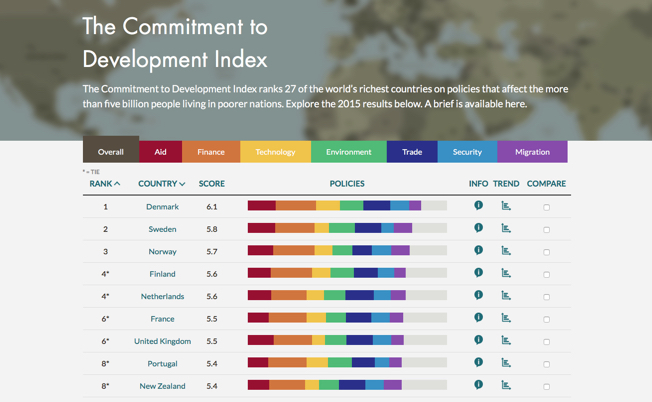Policymakers diverting funds earmarked for long-term investments to pay for immediate political fire-fighting, then using accounting technicalities to conceal their budgetary sleight of hand. NGOs calling attention to the high-stakes shell game, only to see the government practices worsen the next year. This all sounds depressingly familiar, doesn’t it?
What’s surprising is where it’s happening: in the very countries that have been the standard-bearers of good governance, transparency, and adherence to a long-term vision of fairness in social and economic development around the world.
The Center for Global Development’s 2015 Commitment to Development Index
In Denmark, Sweden, Norway, the Netherlands, and other European countries, government funding for international aid—known as official development assistance—is increasingly being reassigned to cover the expenses of receiving and resettling refugees within the donor countries’ borders. But thanks to a specific set of international reporting rules, the totals for aid spending remain high—so high, in fact, that those countries are likely to retain their ranking atop the Center for Global Development’s Commitment to Development index.
The shift in funding is dramatic. In 2016, Denmark intends to spend one-third of its total aid budget—some $600 million—to cover refugee support within its own borders. Sweden and Norway are making even more drastic reallocations.
These are countries that have been stalwart supporters of long-term development investments in many countries in Africa and Asia. Their funding has permitted both the public sector and non-governmental organizations to improve education, provide vital health services, protect the rights of women and girls, and expand the infrastructure that allows farmers to get products to market and businesses to create jobs for young people. They have been among the most active advocates for generous, predictable, transparent aid flows, often chastising the United States for failing to adopt effective practices such as participation in sector-wide pooled funding aligned with the priorities of recipient governments. They were also influential in promoting ambitious international goal-setting, codified in the Sustainable Development Goals agreed by UN member states just a few months ago.
The consequences of these budget cuts are profound. Many of the non-governmental organizations we support have learned recently that promised funding will be cut by 30% or more, leaving them unable to finish projects and, in some cases, threatening the viability of the organizations themselves. NGOs have few, if any, alternative sources to draw on. (Although our own funding to them remains steady, we are unable to fill in this sudden gap.) Governments, too, are reeling from cuts in programs that have long been dependent on donor aid. The most likely public sector response will be to seek greater support from other sources, and particularly from China.
But this is more than a story about changing priorities in a stressed-out world; it’s a story about transparency. European donor countries are able to shift resources to needs within their own borders while appearing to be as generous as they have always been for one simple reason: the Organization for Economic Cooperation and Development (OECD) permits “in-donor refugee costs”—expenditures related to receiving and resettling refugees during the first 12 months—to be included in the reported totals of official development assistance. While this has been allowed informally since the early 1980s, and formally since a 1988 Statistical Reporting Directive from the OECD Development Assistance Committee (available in this 2013 report), the practice has gained in popularity in the past couple of years. As the challenge of refugees has grown, governments in Northern Europe have applied the reporting rule with more vigor and less rigor. They have shifted large shares of their aid budgets, including to expenses associated with resettlement past the 12-month mark. Several watchdog NGOs in Europe have tried to draw attention to this budget game, seeking to galvanize opposition to the use of aid resources for donor-country needs. To date, those efforts appear to have failed, in part because the overall “aid” numbers stay high and the pain is being felt far away.
Without question, the explosive increase in refugees from Syria and many other countries is putting a major strain on European countries, and the response demands that resources be mobilized. The money must be found somewhere. But drawing resources down from development assistance is short-sighted, sacrificing long-term benefits and the disrupting important work in progress. And exploiting OECD reporting rules hides the governments’ actions from their own people—taxpayers who, in the past, set the standard for global citizenship. They deserve better, and so do these European countries’ longtime partners in the developing world.



